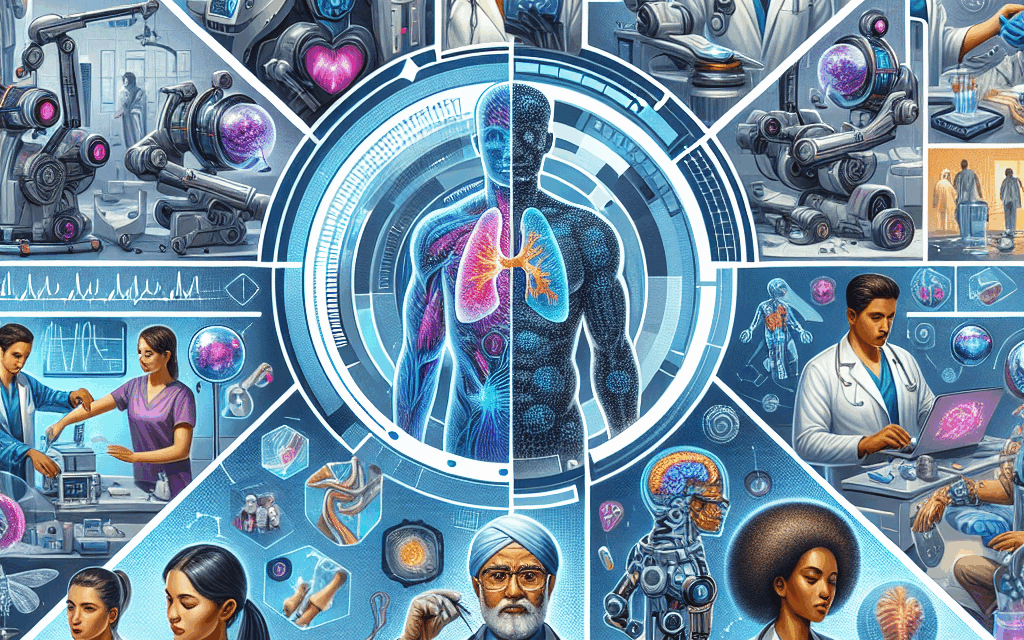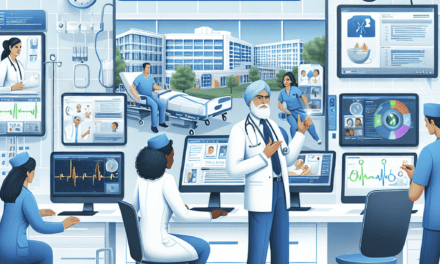Transforming Healthcare and Life Sciences: The Impact of Automation and Future Trends
The healthcare and life sciences sectors are undergoing a profound transformation driven by automation and technological advancements. As these industries grapple with increasing demands for efficiency, accuracy, and patient-centered care, automation emerges as a pivotal force reshaping their landscapes. This article delves into the multifaceted impact of automation on healthcare and life sciences, exploring key trends, challenges, and future directions.
1. The Rise of Automation in Healthcare
Automation in healthcare refers to the use of technology to perform tasks that traditionally required human intervention. This encompasses a wide range of applications, from administrative processes to clinical decision-making. The rise of automation is fueled by several factors, including the need for cost reduction, improved patient outcomes, and the management of vast amounts of data.
One of the most significant areas where automation is making strides is in administrative tasks. Healthcare organizations often face overwhelming paperwork and bureaucratic processes that can detract from patient care. By automating scheduling, billing, and patient record management, healthcare providers can streamline operations and reduce the burden on staff. For instance, robotic process automation (RPA) can handle repetitive tasks such as data entry, allowing healthcare professionals to focus on more complex responsibilities.
Moreover, automation is enhancing clinical workflows. Electronic health records (EHRs) have become a staple in modern healthcare, enabling providers to access patient information quickly and efficiently. Advanced algorithms can analyze patient data to identify trends and predict outcomes, supporting clinical decision-making. For example, machine learning models can assess patient histories to recommend personalized treatment plans, improving the quality of care.
Statistics underscore the impact of automation in healthcare. According to a report by McKinsey, automation could save the healthcare industry up to $150 billion annually by 2026. This potential for cost savings is driving many organizations to invest in automation technologies.
2. Enhancing Patient Care Through Automation
Automation is not just about improving operational efficiency; it also plays a crucial role in enhancing patient care. By leveraging technology, healthcare providers can offer more personalized, timely, and effective services to patients.
Telemedicine is one of the most prominent examples of how automation is transforming patient care. With the advent of telehealth platforms, patients can consult with healthcare professionals remotely, reducing the need for in-person visits. This is particularly beneficial for individuals in rural areas or those with mobility challenges. A study published in the Journal of Medical Internet Research found that telemedicine consultations can lead to similar health outcomes as traditional in-person visits, demonstrating its effectiveness.
Furthermore, automation facilitates continuous patient monitoring through wearable devices and remote monitoring systems. These technologies collect real-time data on patients’ vital signs, activity levels, and other health metrics. For instance, devices like smartwatches can track heart rates and alert users to irregularities, prompting timely medical intervention. This proactive approach to healthcare can significantly improve patient outcomes and reduce hospital readmissions.
Automation also enhances patient engagement. Chatbots and virtual assistants are increasingly being used to provide patients with information, answer questions, and schedule appointments. These tools can operate 24/7, ensuring that patients have access to support whenever they need it. A survey by Accenture found that 77% of patients are willing to use virtual health assistants for basic inquiries, highlighting the growing acceptance of automated solutions in healthcare.
3. The Role of Automation in Drug Development
The life sciences sector, particularly drug development, is another area where automation is making significant inroads. The traditional drug development process is notoriously lengthy and expensive, often taking over a decade and costing billions of dollars. Automation has the potential to streamline this process, making it more efficient and cost-effective.
High-throughput screening (HTS) is a prime example of automation in drug discovery. This technique allows researchers to rapidly test thousands of compounds for their potential therapeutic effects. Automated robotic systems can perform these tests with high precision, significantly reducing the time required to identify promising drug candidates. For instance, a study published in Nature Biotechnology demonstrated that automated HTS could accelerate the identification of new cancer therapies by several months.
Moreover, automation is enhancing data analysis in drug development. The integration of artificial intelligence (AI) and machine learning algorithms enables researchers to analyze vast datasets generated during clinical trials. These technologies can identify patterns and correlations that may not be apparent through traditional analysis methods. For example, AI-driven platforms like IBM Watson have been used to analyze clinical trial data, leading to more informed decision-making and faster drug approvals.
Additionally, automation is improving the manufacturing process of pharmaceuticals. Continuous manufacturing techniques, which utilize automated systems to produce drugs in a streamlined manner, are gaining traction. This approach not only reduces production costs but also enhances product quality and consistency. The FDA has recognized the potential of continuous manufacturing and is actively promoting its adoption in the pharmaceutical industry.
4. Challenges and Ethical Considerations of Automation
While the benefits of automation in healthcare and life sciences are substantial, several challenges and ethical considerations must be addressed. As organizations increasingly rely on automated systems, concerns about data privacy, security, and the potential for bias in algorithms arise.
Data privacy is a paramount concern in healthcare, where sensitive patient information is often stored and processed. The implementation of automation technologies necessitates robust data protection measures to safeguard patient confidentiality. Healthcare organizations must comply with regulations such as the Health Insurance Portability and Accountability Act (HIPAA) in the United States, which sets strict standards for the handling of personal health information.
Moreover, the use of AI and machine learning in clinical decision-making raises ethical questions about accountability and transparency. If an automated system makes a recommendation that leads to a negative patient outcome, who is responsible? Healthcare providers must ensure that they understand the algorithms driving these systems and can explain their decisions to patients. This transparency is crucial for maintaining trust in automated solutions.
Bias in algorithms is another critical issue. If the data used to train AI models is not representative of diverse populations, the resulting algorithms may perpetuate existing disparities in healthcare. For instance, a study published in the journal Science found that an AI algorithm used in healthcare disproportionately favored white patients over Black patients in its risk assessments. Addressing bias in AI systems is essential to ensure equitable healthcare delivery.
5. Future Trends in Healthcare Automation
The future of healthcare and life sciences automation is poised for further evolution, driven by advancements in technology and changing patient expectations. Several key trends are likely to shape the landscape in the coming years.
One significant trend is the increasing integration of AI and machine learning into clinical workflows. As these technologies continue to mature, they will play a more prominent role in diagnostics, treatment planning, and patient monitoring. For example, AI algorithms are being developed to analyze medical imaging data, enabling faster and more accurate diagnoses of conditions such as cancer.
Another trend is the rise of personalized medicine, facilitated by automation. As healthcare providers gather more data on individual patients, they can tailor treatments to meet specific needs. Automation will enable the analysis of genetic information, lifestyle factors, and treatment responses, leading to more effective and targeted therapies.
Additionally, the adoption of blockchain technology in healthcare is gaining traction. Blockchain can enhance data security and interoperability, allowing for secure sharing of patient information across different systems. This technology has the potential to streamline processes such as drug supply chain management and clinical trial data sharing.
Finally, the ongoing shift towards value-based care will drive the adoption of automation in healthcare. As providers focus on improving patient outcomes rather than the volume of services delivered, automation will play a crucial role in tracking and measuring performance metrics. This shift will require healthcare organizations to invest in technologies that support data collection and analysis.
Conclusion
The impact of automation on healthcare and life sciences is profound and far-reaching. From enhancing patient care to streamlining drug development processes, automation is transforming the way these industries operate. However, as organizations embrace automation, they must navigate challenges related to data privacy, algorithmic bias, and ethical considerations.
Looking ahead, the future of healthcare automation is bright, with trends such as AI integration, personalized medicine, and blockchain technology poised to shape the landscape. By leveraging these advancements responsibly, healthcare providers can improve patient outcomes, reduce costs, and ultimately create a more efficient and effective healthcare system.
In summary, the transformation of healthcare and life sciences through automation presents both opportunities and challenges. As stakeholders in these industries work to harness the power of technology, they must remain vigilant in addressing ethical concerns and ensuring that automation serves to enhance, rather than hinder, the quality of care delivered to patients.





